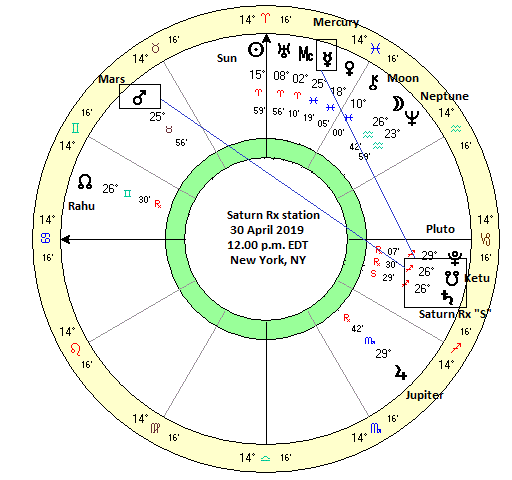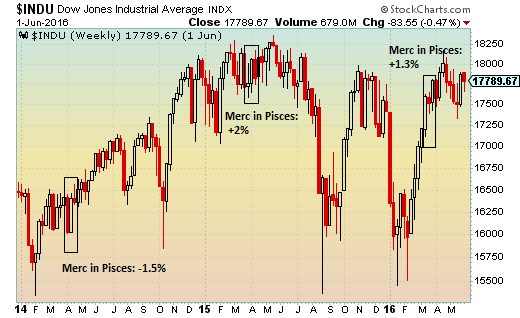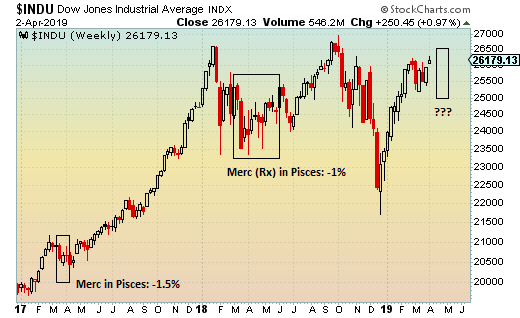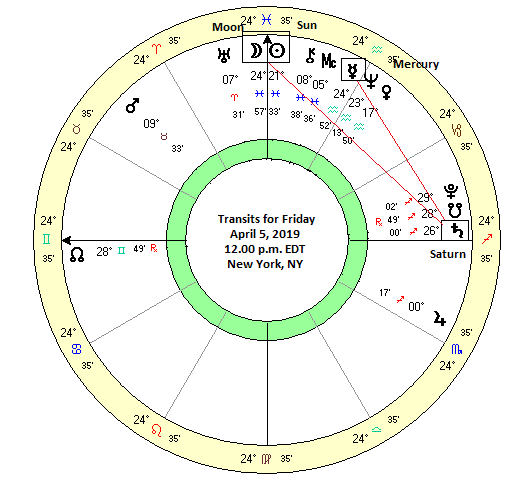.jpg) (15 April 2019)
(15 April 2019)
Financial markets appear to be on auto-pilot these days as the grind
higher continues. After its scary Christmas low, the bull market would
appear to back on track against a background of easy central bank
money (i.e. debt) and the promise of a US-China trade deal that, like
Godot, never seems to arrive. The strength of the rebound in the first
quarter was not unexpected from the astrological point of view given
the extended dominance of Jupiter.
When Jupiter is strong through alignment with other planets or by sign
placement, stocks usually rise. That was definitely the case as Jupiter
aligned with Neptune in January and then with Pluto in February and
March. Jupiter then stationed retrograde last week on April 10 in
Sagittarius, a sign in which it does particularly well. But now that
Jupiter is moving backwards towards Scorpio, we may be on the verge of a
shift in the terrain.
If the winter was all about Jupiter, it seems more likely that the spring will be focused on Saturn. Saturn is the
yang to Jupiter's
yin and
is typically a bearish influence when it is prominent. The bear may
be wakening from hibernation when Saturn turns retrograde on April 30
and begins its annual four-month backward journey through the sky.
While the Saturn retrograde cycle is neither bullish or bearish for
stocks, collective sentiment can become more negative if Saturn forms
tense alignments with other planets.
As it happens, this is very much the case here in 2019. Saturn will
turn retrograde while in a very close conjunction with the South Lunar
Node. (aka Ketu). In traditional astrology, both Eastern and Western,
Ketu is considered to be an influence that undermines the material world
in favour of the spiritual or transcendent realms. In market terms,
Ketu is bearish. So the question is: what happens when two naturally
bearish planets like Saturn and Ketu are in conjunction?
Saturn-Ketu conjunctions: pessimism and the disruption of structures
While markets are not
always bearish when these two planets
combine, there is a greater risk of declines during the time of their
conjunction. As Saturn conjoins Ketu about once every 11-12 years, this
malefic pairing has coincided with some notably negative events. The
last time Saturn conjoined Ketu was in October 2007, right at the time
of the market peak before the financial meltdown. The top of market
took place on October 11, while Saturn was conjunct Ketu (True South
Node) less than two weeks later on October 23. Stocks were beginning
to weaken under this conjunction and US stocks would eventually fall
more than 50% over the next 18 months. While we certainly wouldn't say
it was only because Saturn was aligning with Ketu, it is an
appropriately bearish planetary pattern for the start of a recession and
a bear market.
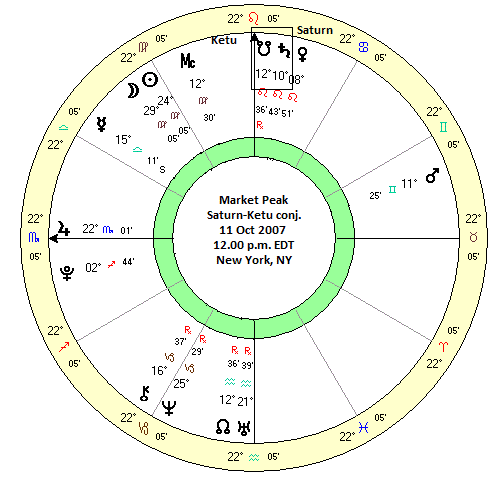
The previous Saturn-Ketu conjunction took place in early January 1997.
Stocks were actually pretty flat during the approach and separation of
this conjunction. This is a useful counter example which reminds us
that no single factor is enough to determine outcomes. Each factor
therefore becomes necessary, but not sufficient. Stocks were also
mostly flat in the previous conjunction in January 1985. Actually, the
market finally began to rally again
after Saturn had begun to
separate from Ketu in mid-January. So we should be aware that there are
benign versions of this conjunction that can point to non-bearish
outcomes in the markets.
But before that, the Saturn-Ketu conjunction was front and center in the
1973-4 bear market. Due to the Saturn retrograde cycle, the
Saturn-Ketu conjunction occurred twice -- once in September 1973 and
then again in February 1974. Much of the world was in the grip of the
Middle East oil embargo, inflation, and deep recession while the US
suffered the added burden of the ongoing Watergate scandal which would
eventually see President Nixon resign in August 1974. And yes, history
could repeat itself in 2019 with Trump coming under pressure to leave
office as Saturn again conjoins Ketu. Since Saturn symbolizes society's
structures and institutions, Ketu's influence undermines them and can
bring about sudden changes.
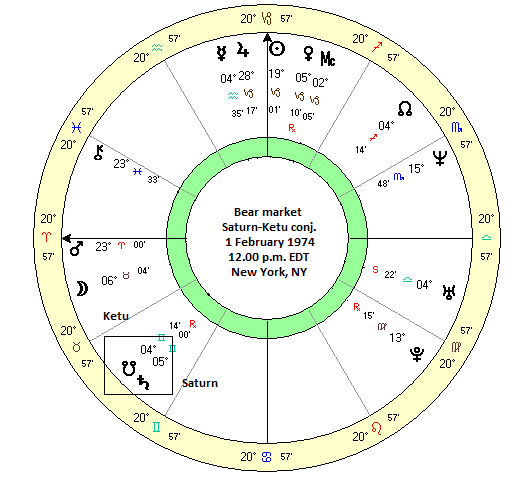
The parallels with 1973-4 are worth taking seriously since Saturn is
also going to have an extended conjunction with Ketu in 2019 because of
its retrograde cycle. Saturn is conjunct with Ketu now and will remain
in very close proximity to Ketu until October. This means there will
be a longer time window for any latent negative sentiment to be
triggered by passing alignments with other bad planets, such as Mars.
"Sell in May and go away"? Or maybe sell in April to beat the rush to
the exits.
Just to round out this brief historical survey, it is worth recalling
that the preceding Saturn-Ketu conjunction took place at the height of
the Cuban Missile Crisis in October 1962. Stocks fell 7% during the
critical period of geopolitical uncertainty of October 16-28 when the
world was teetering on the precipice of a nuclear confrontation.
And while the October 1950 conjunction was a nothingburger in terms of
stocks (although the Korean War had just begun in June of that year),
the previous Saturn-Ketu alignment occurred in late August 1939, less
than a week before World War Two began. As in 1973-4, Saturn would
undergo its entire retrograde cycle while in close conjunction with Ketu
during the second half of 1939 and into January 1940. US markets were
actually flat-to-positive for much of this Saturn-Ketu period, even if
they would eventually go on to lose 40% of their value in the coming
two years in the depth of that conflict.
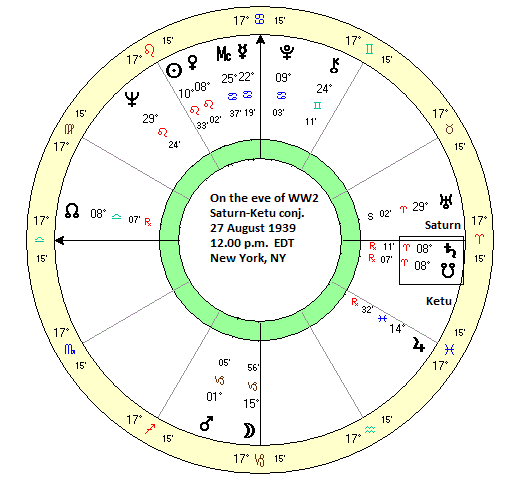
As we can see, not all Saturn-Ketu conjunctions are created equal. It
seems that the ones where Saturn is retrograde and thus the conjunction
is extended for a period of months instead of weeks are particularly
troublesome. Since we will experience one of those potentially more
damaging extended conjunctions in 2019, I would think the chances for
significant declines in stocks are much higher, if not in the
April-October period, then in the months following the conjunction
period.
While this isn't quite bullet-proof actionable evidence, it should still
be a warning to investors who are heavily invested in this bull market
rally. Maybe this really is the calm before the storm.
Weekly Market Forecast
US stocks have been 'melting higher' over the past two weeks since my
last post while other global markets have also stayed fairly buoyant.
It is possible the upward bias may shift toward a more sideways or
indecisive market for a little while here before things begin to fall
apart. This week is shortened for Good Friday and will likely feature
some downside. I think Wednesday's Moon-Mercury opposition could
coincide with some selling as Mercury is more vulnerable due to its
transit of Pisces, its sign of debilitation. The nervousness could
begin to manifest on Tuesday afternoon, however. I wouldn't expect too
much damage just yet but it may begin to get the attention of some
market participants.
For a more detailed analysis of the markets, please check out my
weekly subscriber newsletter
which is published every Saturday afternoon (EST). I outline the
key technical and planetary influences for US and Indian stocks
for the short and medium term, as well as currencies, gold and oil.
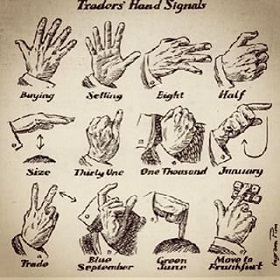 (29 April 2019)
The stock market remains buoyant after Friday's 3.2% US GDP number and
generally positive earnings reports. Some US indexes have made new
all-time highs although the large cap Dow and the small cap Russell
2000 have yet to follow the S&P 500 and NASDAQ into record
territory. Corporate America is thriving in Trump's low-tax,
low-regulation environment, albeit with a helping hand for the Fed and
its ultra-loose monetary policies that encourages leveraging through
higher debt levels. We're probably living in an asset bubble that is
not sustainable in the long run, but as Keynes said, "in the long run,
we are all dead."
(29 April 2019)
The stock market remains buoyant after Friday's 3.2% US GDP number and
generally positive earnings reports. Some US indexes have made new
all-time highs although the large cap Dow and the small cap Russell
2000 have yet to follow the S&P 500 and NASDAQ into record
territory. Corporate America is thriving in Trump's low-tax,
low-regulation environment, albeit with a helping hand for the Fed and
its ultra-loose monetary policies that encourages leveraging through
higher debt levels. We're probably living in an asset bubble that is
not sustainable in the long run, but as Keynes said, "in the long run,
we are all dead.".png)
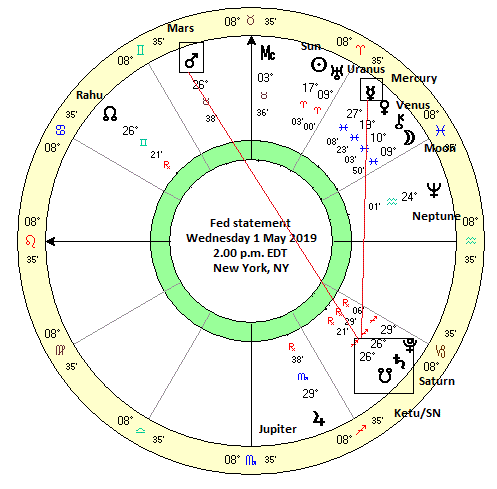

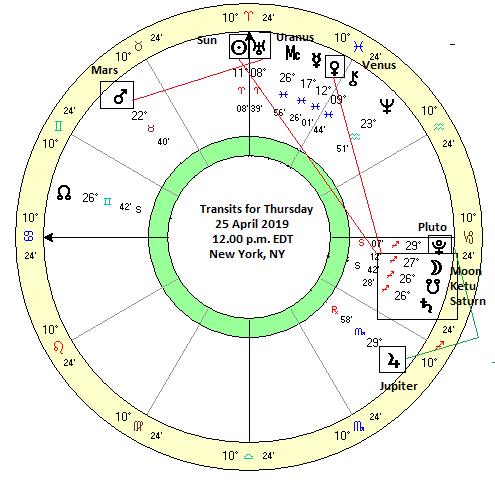
.jpg)
